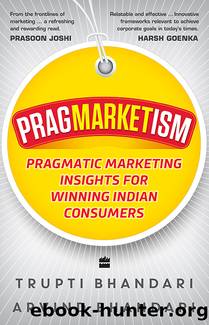Pragmarketism by Arvind Bhandari

Author:Arvind Bhandari
Language: eng
Format: epub
Tags: null
Publisher: HarperBusiness
Published: 2020-08-15T00:00:00+00:00
Source: Authors
As an example, we could now add brands to the above statement and imbue them with a particular meaning, thereby building a brand essence. To empower one to achieve status, through the way you look and feel: Raymond. To provide the opportunity to satisfy cravings through unbeatable chocolate desserts: Cadburyâs Dairy Milk. To encourage communities of the like-minded and the striving: Bajaj Pulsar (like the Harley Group). To explore oneâs creative urge with writing instruments: Camlin. To bring stability through structures that makes the bedrock of relations: ACC cement. To find freedom, with nothing to hold me back: Stayfree. To live fuller with my best look forward: Nivea.
Now, there are a few clear advantages in writing the brand benefits in this manner, as outlined below:
a)Itâs written in keeping with the consumerâs interest. All statements above could have been written directly as, to achieve status, satisfy cravings, build communities and so on, but that would be an exaggerated claim that lacks authenticity. The thought, on the contrary, is to empower consumers with the opportunity of meeting their need-states with the brand in tow. This way, the consumers can sit at the front wheel and the brand takes the back seat, happy to support the consumerâs aspirations.
b)The need-states are not operating at the feature-benefit level of Maslow, but are operating at the higher order, going all the way to the top rung of self-actualization. In the above examples, the italicized portion refers to what the brand is currently focusing on with their given product range. But should it decide to go beyond the existing product range, the same philosophy should enable it to do so with ease, without any internal conflict or external consumer dissonance. Thus, Camlinâs core need-state is satisfaction, which is aligned with expression and creativity. Its brand essence allows it go into curating and promoting art from a brand that produces writing instruments. Nivea is about living fuller lives â whatever that may entail â and not merely selling creams. If it desires to expand into grooming parlours, that should pose no difficulty. By focusing on the core need-state that forms the brandâs bullseye, its enablers unshackle the business from the existing product format and allow it to look beyond.
To come back to our earlier question â what are brands all about? The answer tends to become somewhat abstract in the final analysis. Brand essence, then, is the philosophy of the brand, which helps the consumers meet their desired need-states at all levels. The greater and more completely it satisfies the need-states, the stronger it becomes. But for that to happen, the brand should connect at the core need-level and not walk away when its basic product or service level need has been met.
Now that we have a good brand, how do we create brands that receive love? What is the road to becoming iconic, cult-like brands? More importantly, how do we create brands that are made in India or adapted in India for our tricolour nation? As
Download
This site does not store any files on its server. We only index and link to content provided by other sites. Please contact the content providers to delete copyright contents if any and email us, we'll remove relevant links or contents immediately.
Art of The Strategic Side Hustle: Simple Steps to Developing a Passive Income Side Hustle (The Strategic Series) by Hodge Kimberly(100)
An MBA in a Book by Xander Cansell(96)
The Art of Building Your Resilience and Adaptability by Néstor Gandara(82)
Pragmarketism by Arvind Bhandari(80)
Whole Numbers and Half Truths: What Data Can and Cannot Tell Us About Modern India by Rukmini S(68)
Under the Skin of the Indian Consumer by David Abikzir(63)
The Sharesies Guide to Investing by Brooke Roberts & Leighton Roberts and Sonya Williams(63)
Corporate Chanakya on Leadership by Radhakrishnan Pillai(61)
Aesthetic Labour by Warhurst Chris;Nickson Dennis; & Dennis Nickson(59)
Breakpoints by Mike Ashby(57)
Playing for Time by Jeremy Lewis(57)
IEC 61636-2-2023 (IEEE Std 1636.2) by IEC(54)
Dream Believe Create by Hayley Lewis(52)
Crisis Investing for the Rest of the '90s by Douglas Casey(51)
Non-Profit Legends for Humanity and Good Citizenship by Moore Hank;(51)
Case of the Bonsai Manager by R Gopalakrishnan(50)
IEC 61136-1-1992 scan by Unknown(48)
Fine Printing and Private Presses by Roderick Cave(46)
SMARTS: Are We Hardwired for Success? by CHUCK MARTIN PEG DAWSON AND RICHARD GUARE(39)
